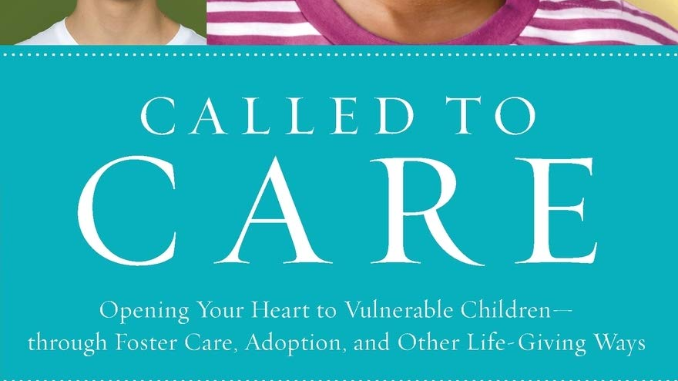
Published by Bethany House on September 17, 2019
Genres: Non-Fiction, Christian Life, Adoption
Buy on Amazon
Goodreads

More and more individuals, families, and churches are seeking ways they can respond to the biblical mandate to care for "the least of these." The desire to help children coming from difficult situations is a necessary starting point, but what comes next? You need to know the steps for getting involved and what will truly help.
Filled with real-life stories and practical advice, Called to Care starts by helping you honestly assess your motivation to help--sometimes the wrong motivation sets the stage for an unsuccessful experience. From there, the book shows what adoption and foster care really look like in a variety of situations, from domestic and international adoptions to short-term foster care and foster-to-adopt arrangements.
Also included is how churches and individuals can minister to refugees. Rounding out this comprehensive yet concise book are tips for assessing your preparedness, how to meet common emotional and physical challenges, and the most effective ways to help families stay together and thrive.
Bethany is a global nonprofit that supports children and families with world-class social services, all designed to help families thrive. We believe every child deserves to be loved, connected, and empowered through family.
Right now, there are 123,000 children awaiting adoption in the United States alone. There were 270,000 new instances of children being placed into foster care. And yet there were only 59,400 adoptions. There is a great need for people to serve as foster parents, adoptive parents, court-appointed special advocates, social workers, and other places within this field of caring. We must do better.
Many people recognize the need, very few people feel like they can get involved. They aren’t sure where to start, or their only experience with adoption is some sort of medical needs they’re unfamiliar with, or they feel adoption doesn’t match with their financial situation. Called to Care is here to help. It methodically takes readers through four parts of the call, providing engaging real-life stories and experiences along the way.
Part One: Examining the Call to Care focuses on the theological aspect, providing the foundation for the care of the poor, the sick, and the orphan as a Scriptural mandate that we must respond to in some manner.
Part Two: Exploring Foster Care and Adoption details the differences between the two, explains the difference types of foster care and adoption, and gives case studies that help us see when each might be most beneficial for the child and first family involved.
Part Three: Embracing Family Preservation covers a topic that is all-too-often missing in the adoption/foster care world. How do we prevent families from being disrupted in the first place? How do we mitigate issues like drug addiction, abuse, or poverty? What can we do to keep families together? What resources can we provide? I really wish this would have come before part two, because it helps set the child-first mindset that is so important.
Part Four: Enriching Family Ties discusses how families, friends, churches, and communities can step up to make a difference to struggling families, foster families, adoptive families, and everyone in between. This is a much-needed resource. Even as a pastor, I found myself constantly dealing with the fact that my church really was not well-versed in understanding or handling our adoption journeys.

Called to Care stands out because of its emphasis on the child and the first family, rather than the foster/adoptive family. It correctly places their needs first and challenges prospective foster/adoptive parents to truly understand their motivations and check their expectations.
As the adoptive father of two kids, I can tell you that most of the literature is focused on me as the parent. There are expectations of infertility (no, this is just how we’ve chosen to create a family). There is surprise that we want our children to be engaged in an open-adoption with their birth families, insofar as it is safe. There is always some thing like “You tried everything else, now here’s adoption.”
Called to Care really recognizes that shouldn’t be the case. Adoption is never a plan A: that’s the redemption of the family. But the adoptive world can treat it as such, and really not care for the birth family, or understand their loss and their trauma. This book doesn’t shy away from addressing that, and for that alone, I would recommend it to anyone considering adoption or foster care.
I also appreciate how much it goes into the various types of allied care that can come with adoption or foster care. Can you not take on the commitment of an adoption? This book will give you resources to become a court-appointed special advocate (CASA) for children in foster care. It will tell you how to come alongside birth mothers and foster mothers and adoptive mothers and help address their individual needs.
It also lays a great groundwork in the different types of adoption: from foster care, domestic, international, special needs, etc. And it addresses the expectation of adoption (open, semi-open, closed) and unbiasedly discusses when each might be most appropriate. If you know nothing, but want an easy way to learn the basics, Called to Care is the place to start. They also have a great section for further reading that will help you along the journey.
Listen, this is hard work. Whether it’s adoption, foster care, CASA, respite care, working with birth moms, or even work with refugees—whatever it is. But it’s the Gospel. We have to do it. Bill Blacquiere and Kris Faasse give readers a gentle nudge and a place to start. As the adoptive dad of two kids, this is the book I wish I’d read before we started our journey.



